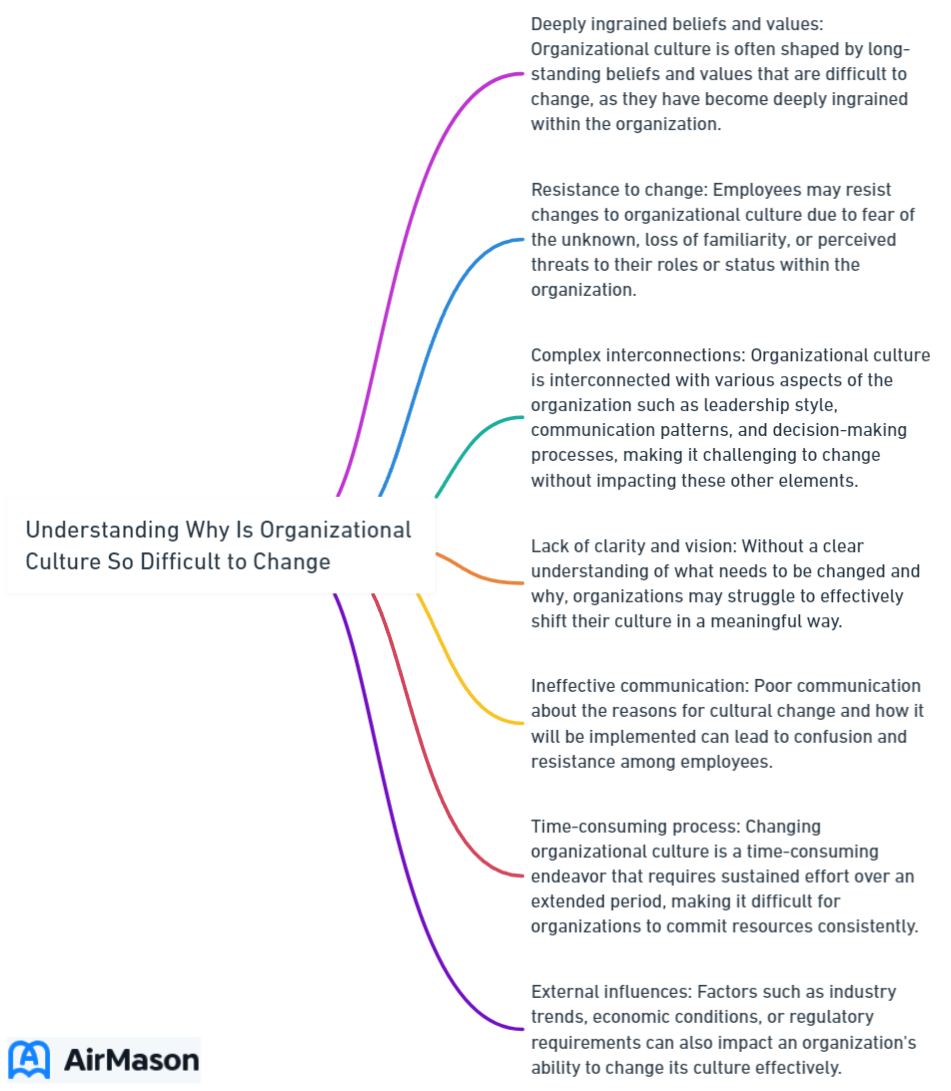
Organizational culture has been a hot topic for years, but as we face the challenges of 2024, it has become even more crucial for companies to adapt and evolve. The ever-changing business landscape demands a fresh perspective on cultural change, and understanding “why is organizational culture so difficult to change” is key to overcoming the challenges it presents. In this blog post, we will delve into the complex nature of organizational culture, explore the factors contributing to resistance in cultural change, and discuss strategies for overcoming these challenges. We will also provide real-life examples of successful organizational culture change to demonstrate the importance of strong leadership, employee engagement, and clear goals.
Key Takeaways
- Organizational culture is a complex tapestry of values, beliefs, norms and behaviors that presents a major challenge for leadership to modify.
- Organizations must understand factors contributing to resistance in cultural change and adopt proactive strategies such as aligning leadership with vision, engaging employees and implementing incremental changes.
- An effective culture change plan requires assessment & diagnosis, setting clear goals & objectives and tracking progress while making necessary adjustments.
The Complex Nature of Organizational Culture
An organization’s culture, a complex weave of deeply rooted values, beliefs, norms, and behaviors, forms the culture of an organization and guides its decision-making processes. Implementing organizational culture change frequently presents a significant leadership challenge. This challenge arises due to the organization’s culture encompassing tangible and intangible elements, which are often hard to measure and alter.
Broadly, one can divide organizational culture into two primary components: values and beliefs, which are often rooted in basic assumptions, followed by norms and behaviors.

An Organization’s Culture
An organization’s culture is the collective set of values, beliefs, and behaviors that shape its identity and guide the conduct of its members. It serves as the foundation upon which decisions are made, strategies are formed, and interactions occur within the workplace. This cultural framework influences everything from employee morale to productivity levels. A strong organizational culture fosters a sense of belonging and purpose among employees, leading to higher job satisfaction and retention rates. Conversely, a poorly defined or conflicting culture can result in disengagement and inefficiencies. Therefore, it is crucial for leaders to actively cultivate and reinforce a positive and cohesive organizational culture, as it ultimately defines the character and success of the entity.
Values and Beliefs
Core principles, namely values and beliefs, mold the organization’s culture, influence decision-making, and command employee behavior. These principles establish a decision-making framework, warranting choices that align with the company’s mission statement and long-term goals. This, in turn, influences how employees interact with clients, vendors, and other stakeholders, as they align their actions with the organization’s values and beliefs.
A strong culture, built on shared values and beliefs, creates a work environment where employees feel motivated, engaged, and driven to perform at their best. This can have a significant effect on employee satisfaction, retention, and overall company performance.
Norms and Behaviors
The visible expressions of an organization’s culture are its norms and behaviors, which mirror the shared values and beliefs intrinsic to its culture. They dictate what is considered appropriate and expected behavior within the organization, guiding employees in their interactions with colleagues, customers, and stakeholders. The way employees communicate, make decisions, and solve problems can all be traced back to the underlying norms and behaviors of the organization.
When it comes to cultural transformation, norms and behaviors hold a pivotal role in the successful metamorphosis of corporate culture. Consistent and regular follow-up is essential in instilling new behaviors, which can lead to a successful cultural shift. Addressing these elements during a culture change process can help organizations overcome resistance and create a more supportive work environment that drives growth and success.
Factors Contributing to Resistance in Cultural Change

Various factors like fear of the unknown, mistrust, and insufficient communication, particularly during large-scale changes, can contribute to resistance against cultural change. These factors can make it difficult for organizations to successfully implement change initiatives and achieve their desired outcomes. By understanding the reasons behind resistance to change, organizations can develop strategies and solutions to address these challenges and facilitate a smooth and successful transition.
Organizations must acknowledge that surmounting resistance to cultural change is not a walk in the park—it demands a unified effort from all organizational levels. By acknowledging the factors contributing to resistance and adopting a proactive approach, organizations can better navigate the challenges of cultural change and foster an environment that supports growth, innovation, and success.
Fear of the Unknown
Fear of the unknown can fuel employee resistance to change, as individuals may harbor fears about potential negative impacts and disruptions to the status quo. Employees might worry about job loss, decreased compensation, and uncertainty about their future and the future of the organization. Prior experiences with unsuccessful changes can also contribute to such apprehensions.
To address this fear, organizations must provide a sense of certainty and clarity about the change, helping employees feel more secure and open to the change. This can be achieved through effective communication, involvement of employees in the change process, and clear articulation of the benefits and rationale behind the change.
Lack of Trust and Buy-in
Lack of trust and acceptance from employees can hinder culture change initiatives, as they might fail to see the benefits or feel excluded from the process. Effective communication practices can help build trust and facilitate the change process, but garnering buy-in from employees is also crucial for success.
Involving employees in the change process, addressing their concerns, and setting realistic expectations can help build trust and buy-in.
- Create a safe environment for employees to express their thoughts and feelings
- Share information openly about the change
- Ensure leaders are competent, prepared, and accountable for the change
These actions can contribute to building trust and commitment among the workforce.
Ineffective Communication
Ineffective communication can lead to:
- Unclear objectives
- Misunderstandings
- Reduced morale
- A toxic work environment
- Poor decision-making
- Decreased productivity
- Demotivated employees
- Workplace conflicts
- Overall efficiency reduction
All of these factors can obstruct company culture change. When there is a lack of transparency and clear communication, employees may struggle to understand and identify with the new values, leading to a lack of trust and buy-in.
To overcome the challenges posed by ineffective communication, organizations must develop and implement effective communications practices that provide clear, concise, and consistent information about the change.
To achieve this, organizations should:
- Involve employees in the change process
- Ensure that leaders are able, ready, and accountable for the change
- Foster a culture of trust, understanding, and commitment to the change process
By following these strategies, organizations can improve communication and increase the likelihood of successful change implementation.
Strategies for Overcoming Challenges in Changing Organizational Culture

Although the task of altering organizational culture is intimidating, the right strategies and approaches can facilitate a successful transformation. Key strategies to overcome challenges in changing organizational culture encompass aligning leadership with vision, engaging employees, and implementing incremental changes. By adopting these strategies, organizations can change organizational culture, creating a supportive environment that nurtures growth, innovation, and success.
These strategies not only help to address the factors contributing to resistance in cultural change, but they also provide a roadmap for organizations to follow as they embark on their culture change journey. With strong leadership, employee engagement, and a clear vision for change, organizations can successfully navigate the challenges of cultural transformation and emerge stronger and more resilient.
Aligning Leadership and Vision
Aligning leadership and vision in organizational culture change is of critical importance, as it guarantees that upper management is devoted to the change and provides a precise direction for the organization. By making decisions that reflect the stated values of an organization, executives gain the support, respect, and trust of their employees.
To align leadership and vision during the change process, organizations can:
- Formulate a comprehensive strategy
- Offer role modeling and training for leaders
- Examine the current culture
- Connect work units with strategic objectives
This alignment ensures that the change is successful and that employees are invested and motivated to support the change.
Engaging Employees

Employee engagement is crucial for the success of cultural change, as it helps to build trust, gain buy-in, and create a sense of ownership among the workforce. Engaging employees in the change process ensures that they understand the reasons behind the change, feel included in the decision-making process, and are motivated to contribute to its success.
To engage employees in the change process, organizations can:
- Provide an environment for employees to voice their opinions
- Address any employee concerns
- Establish reward and recognition systems with clear criteria and metrics
By involving employees in the transformation process, organizations can foster a culture of trust, commitment, and ownership that drives successful change.
Implementing Incremental Changes
Implementing incremental changes in an organizational culture change offers several advantages, such as:
- Controlled and measured adjustments
- Retention of core values and culture
- Speedy implementation
- Enhanced adaptability
This approach allows employees to gradually adjust and adapt to the new culture, reducing resistance and increasing the likelihood of success.
The process of implementing incremental changes in organizational culture involves:
- Making small, yet meaningful improvements to business processes, systems, and practices over time
- Accurately identifying areas for improvement
- Setting specific goals
- Gradually implementing changes step by step
By following this process, organizations can successfully change culture and achieve their desired outcomes while considering processes values.
Good Working Environment Examples
Good working environment examples encompass various elements that foster productivity, satisfaction, and well-being among employees. One notable example is a flexible work schedule, which allows employees to balance their professional and personal lives effectively. This can lead to increased job satisfaction and reduced stress levels. Another crucial aspect is open and transparent communication within the organization, ensuring that employees are well-informed about company goals, expectations, and any changes in policies. Providing opportunities for skill development and career growth is also essential. When employees see a clear path for advancement, they are more likely to be motivated and engaged in their work. Moreover, a supportive and inclusive company culture that values diversity and encourages collaboration can significantly contribute to a positive working environment. Lastly, physical workspace design matters too; a well-designed office with comfortable furniture, proper lighting, and spaces for relaxation can enhance overall well-being and productivity.
Real-Life Examples of Successful Organizational Culture Change

Despite the overwhelming challenges of altering organizational culture, real-life examples of successful transformations show its feasibility with the correct approach. Strong leadership, employee engagement, and clear goals are essential components for success in these examples. By examining the experiences of companies that have successfully transformed their culture, we can gain valuable insights and lessons that can be applied to other organizations facing the most difficult leadership challenges in their large scale undertaking.
In the following sections, we will explore organizational culture change examples by examining two real-life cases of successful organizational culture change: Company A, which prioritized employee satisfaction, and Company B, which focused on innovation and collaboration. These examples showcase the importance of aligning leadership and vision, engaging employees, and implementing incremental changes in driving successful organizational culture change.
Company A
Company A successfully changed its culture by prioritizing employee satisfaction, leading to improved customer service and increased profits. By placing emphasis on employee satisfaction, Company A was able to create a positive work environment that motivated employees to perform at their best and deliver exceptional customer service.
The leadership team at Company A recognized the importance of employee satisfaction in driving the company’s success and implemented policies and programs that supported this goal. As a result, Company A experienced significant growth and improved customer satisfaction, providing a clear example of the positive impact that a well-executed culture change can have on a company’s bottom line.
Company B
Company B transformed its culture by focusing on innovation and collaboration, resulting in a more agile and competitive organization. By prioritizing innovation and collaboration, Company B was able to create an environment that encouraged employees to share ideas, experiment, and work together to drive the company’s success.
The leadership team at Company B took several measures to transition its organizational culture towards innovation and collaboration, including:
- Aligning company goals and culture
- Incentivizing values that foster innovation and collaboration
- Incorporating innovation into company practices
- Introducing controlled change
- Promoting creativity and innovation
As a result, Company B became more responsive to market changes and increased its competitiveness in the industry.
Essential Components of an Effective Culture Change Plan

For organizations aiming to transform their culture and achieve desired results, an effective culture change plan is imperative. Key elements of an effective culture change plan encompass assessment and diagnosis, setting clear goals and objectives, and tracking progress while making necessary adjustments. By incorporating these components into their change plan, organizations can ensure that their efforts are aligned and focused on the desired outcomes.
In the following sections, we will delve into each of these essential components, exploring their significance in the culture change process and offering guidance on how organizations can effectively implement these elements in their change plans.
Assessment and Diagnosis
The first step in transforming organizational culture is to assess the current culture and recognize elements that are aiding or impeding progress. This involves:
- Evaluating values
- Analyzing hiring practices
- Evaluating employee programs
- Hearing from employees
- Utilizing the Organizational Culture Assessment Instrument
- Scrutinizing stories and narratives
- Monitoring behaviors
- Collecting employee feedback through surveys
Comprehensive assessment and diagnosis can provide organizations with valuable insights into their current culture, highlighting areas of strength and potential for improvement. This information can then be used to develop a targeted and effective culture change plan that addresses the specific needs and challenges of the organization.
Clear Goals and Objectives
When endeavoring to modify organizational culture, setting clear goals and objectives is paramount. Clear goals provide a roadmap for the change process, ensuring that all efforts are aligned and focused on the desired outcomes. They also create a structure for evaluating progress and success, fostering a sense of ownership and involvement in the change process.
By establishing clear goals and objectives, organizations can minimize resistance to cultural change, as employees will have a better understanding of the reasons behind the change and how it will affect their roles and responsibilities. This clarity can help to build trust and buy-in among employees, making it easier to implement the desired cultural changes.
Monitoring Progress and Adjusting as Needed
Tracking progress and making necessary adjustments form a critical part of an effective culture change plan. By tracking the success of their culture change efforts and making necessary adjustments, organizations can ensure long-term success and sustained improvement.
Organizations can gather feedback from employees, evaluate the effectiveness of their change initiatives, and adjust their strategies accordingly to address any challenges or obstacles that arise during the change process. This continuous improvement approach can help organizations achieve their desired culture change outcomes and maintain a strong and adaptive culture that supports growth and success.
Culture of Teamwork
A culture of teamwork is the cornerstone of any thriving organization. It encompasses a set of shared values, beliefs, and practices that prioritize collaboration and mutual support among team members. In such an environment, individuals are encouraged to work cohesively towards common goals, leveraging each other’s strengths and compensating for weaknesses. This culture fosters a sense of belonging and trust, creating a conducive space for innovation and problem-solving. A robust culture of teamwork not only leads to higher productivity but also enhances employee satisfaction and retention. When employees feel valued and integrated into a unified whole, they are more likely to contribute their best efforts, resulting in a more dynamic and successful organization.
Summary
In conclusion, changing organizational culture is a complex and challenging endeavor, but with a thorough understanding of its components, factors contributing to resistance, and effective strategies for overcoming these challenges, organizations can successfully transform their culture. By prioritizing strong leadership, employee engagement, and clear goals, organizations can create a supportive environment that nurtures growth, innovation, and success. As we continue to navigate the ever-changing business landscape of 2024, embracing and adapting to cultural change will be essential for organizations to thrive and stay competitive in the long run.
Frequently Asked Questions
Why it is difficult to change the culture of an organization?
Changing the culture of an organization is a challenging task as it requires people to first recognize their existing unconscious assumptions and then modify them accordingly. This requires active involvement from each individual, making it difficult to alter the culture of an organization effectively.
Is organizational culture easy to change?
Changing an organization’s culture is a difficult leadership challenge that can take months to years to accomplish. It requires a clear rationale for why the company should change, as well as investing in staff and resources to make it successful.
What are the main components of organizational culture?
Organizational culture is comprised of shared values, beliefs, norms, and behaviors that define the way employees interact within an organization.
What factors contribute to resistance in cultural change?
Fear of the unknown, lack of trust and inadequate communication are all key factors that contribute to resistance in cultural change.
How can organizations assess their current culture?
Organizations can assess their current culture by evaluating values, analyzing hiring practices, utilizing the Organizational Culture Assessment Instrument, and collecting employee feedback through surveys.